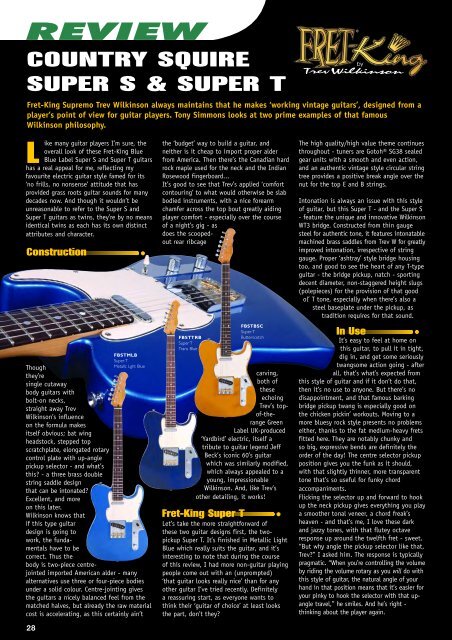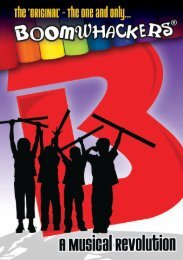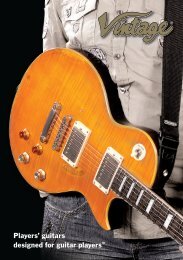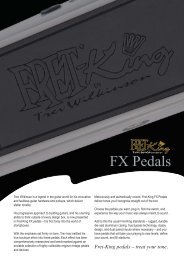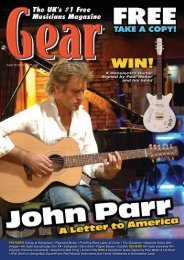GEAR 23_COVER - JHS
GEAR 23_COVER - JHS
GEAR 23_COVER - JHS
You also want an ePaper? Increase the reach of your titles
YUMPU automatically turns print PDFs into web optimized ePapers that Google loves.
COUNTRY SQUIRE<br />
SUPER S & SUPER T<br />
Fret-King Supremo Trev Wilkinson always maintains that he makes ‘working vintage guitars’, designed from a<br />
player’s point of view for guitar players. Tony Simmons looks at two prime examples of that famous<br />
Wilkinson philosophy.<br />
L<br />
ike many guitar players I’m sure, the<br />
overall look of these Fret-King Blue<br />
Blue Label Super S and Super T guitars<br />
has a real appeal for me, reflecting my<br />
favourite electric guitar style famed for its<br />
‘no frills, no nonsense’ attitude that has<br />
provided grass roots guitar sounds for many<br />
decades now. And though it wouldn’t be<br />
unreasonable to refer to the Super S and<br />
Super T guitars as twins, they’re by no means<br />
identical twins as each has its own distinct<br />
attributes and character.<br />
Construction<br />
Though<br />
they’re<br />
single cutaway<br />
body guitars with<br />
bolt-on necks,<br />
straight away Trev<br />
Wilkinson’s influence<br />
on the formula makes<br />
itself obvious; bat wing<br />
headstock, stepped top<br />
scratchplate, elongated rotary<br />
control plate with up-angle<br />
pickup selector - and what’s<br />
this? - a three brass double<br />
string saddle design<br />
that can be intonated?<br />
Excellent, and more<br />
on this later.<br />
Wilkinson knows that<br />
if this type guitar<br />
design is going to<br />
work, the fundamentals<br />
have to be<br />
correct. Thus the<br />
body is two-piece centrejointed<br />
imported American alder - many<br />
alternatives use three or four-piece bodies<br />
under a solid colour. Centre-jointing gives<br />
the guitars a nicely balanced feel from the<br />
matched halves, but already the raw material<br />
cost is accelerating, as this certainly ain’t<br />
28<br />
FBSTMLB<br />
Super T<br />
Metallc Lght Blue<br />
the ‘budget’ way to build a guitar, and<br />
neither is it cheap to import proper alder<br />
from America. Then there’s the Canadian hard<br />
rock maple used for the neck and the Indian<br />
Rosewood fingerboard...<br />
It’s good to see that Trev’s applied ‘comfort<br />
contouring’ to what would otherwise be slab<br />
bodied instruments, with a nice forearm<br />
chamfer across the top bout greatly aiding<br />
player comfort - especially over the course<br />
of a night’s gig - as<br />
does the scoopedout<br />
rear ribcage<br />
FBSTTRB<br />
Super T<br />
Trans Blue<br />
carving,<br />
both of<br />
these<br />
echoing<br />
Trev’s topof-therange<br />
Green<br />
Label UK-produced<br />
‘Yardbird’ electric, itself a<br />
tribute to guitar legend Jeff<br />
Beck’s iconic 60’s guitar<br />
which was similarly modified,<br />
which always appealed to a<br />
young, impressionable<br />
Wilkinson. And, like Trev’s<br />
other detailing, it works!<br />
Fret-King Super T<br />
FBSTBSC<br />
Super T<br />
Butterscotch<br />
Let’s take the more straightforward of<br />
these two guitar designs first, the twopickup<br />
Super T. It’s finished in Metallic Light<br />
Blue which really suits the guitar, and it’s<br />
interesting to note that during the course<br />
of this review, I had more non-guitar playing<br />
people come out with an (unprompted)<br />
‘that guitar looks really nice’ than for any<br />
other guitar I’ve tried recently. Definitely<br />
a reassuring start, as everyone wants to<br />
think their ‘guitar of choice’ at least looks<br />
the part, don’t they?<br />
The high quality/high value theme continues<br />
throughout - tuners are Gotoh® SG38 sealed<br />
gear units with a smooth and even action,<br />
and an authentic vintage style circular string<br />
tree provides a positive break angle over the<br />
nut for the top E and B strings.<br />
Intonation is always an issue with this style<br />
of guitar, but this Super T - and the Super S<br />
- feature the unique and innovative Wilkinson<br />
WT3 bridge. Constructed from thin gauge<br />
steel for authentic tone, it features intonatable<br />
machined brass saddles from Trev W for greatly<br />
improved intonation, irrespective of string<br />
gauge. Proper ‘ashtray’ style bridge housing<br />
too, and good to see the heart of any T-type<br />
guitar - the bridge pickup, natch - sporting<br />
decent diameter, non-staggered height slugs<br />
(polepieces) for the provision of that good<br />
ol’ T tone, especially when there’s also a<br />
steel baseplate under the pickup, as<br />
tradition requires for that sound.<br />
In Use<br />
It’s easy to feel at home on<br />
this guitar, to pull it in tight,<br />
dig in, and get some seriously<br />
twangsome action going - after<br />
all, that’s what’s expected from<br />
this style of guitar and if it don’t do that,<br />
then it’s no use to anyone. But there’s no<br />
disappointment, and that famous barking<br />
bridge pickup twang is especially good on<br />
the chicken pickin’ workouts. Moving to a<br />
more bluesy rock style presents no problems<br />
either, thanks to the fat medium-heavy frets<br />
fitted here. They are notably chunky and<br />
so big, expressive bends are definitely the<br />
order of the day! The centre selector pickup<br />
position gives you the funk as it should,<br />
with that slightly thinner, more transparent<br />
tone that’s so useful for funky chord<br />
accompaniments.<br />
Flicking the selector up and forward to hook<br />
up the neck pickup gives everything you play<br />
a smoother tonal veneer, a chord freak’s<br />
heaven - and that’s me, I love these dark<br />
and jazzy tones, with that flutey octave<br />
response up around the twelfth fret - sweet.<br />
“But why angle the pickup selector like that,<br />
Trev?” I asked him. The response is typically<br />
pragmatic. “When you’re controlling the volume<br />
by riding the volume rotary as you will do with<br />
this style of guitar, the natural angle of your<br />
hand in that position means that it’s easier for<br />
your pinky to hook the selector with that upangle<br />
travel,” he smiles. And he’s right -<br />
thinking about the player again.


